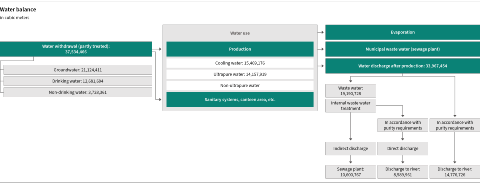Water Management

Sustainable water use strategy
Water is a central resource to all aspects of life and business. Therefore, water management is a crucial element to ensure sustainable use of resources and safeguard business continuity.
We understand sustainable use of water as the efficient water management practices throughout all stages of our operations, always taking into account the water needs of surrounding communities.
The starting point for our successful water management is the published water balance.
Infineon water supply is based on on-site sources (groundwater fed by surface water) and also on local suppliers (drinking and non-drinking water).
It's a fact that semiconductor industry in general requires water for production. However, at Infineon only a small part of the water withdrawal is consumed, whereas a large part is used for cooling purposes only. We consider as consumed water those parts, which end up in sewage plants where the water is treated.
We strive to improve water efficiency and to use water in a sustainable way.
Therefore, we take several actions to increase our water recycling rate. For example, cooling water can be used afterwards to produce ultrapure water for manufacturing that can again be used afterwards for other purposes like washing processes.
Waste water treatment is another priority in our water management. Only after all technical possibilities of water reuse are exploited, Infineon discharges its waste water directly or indirectly depending on its quality, local conditions and official permissions.
Regarding our supply chain, our environmental requirements for suppliers are defined in our Supplier Code of Conduct (former Principles of Procurement). It requires suppliers and service providers to implement an environmental management system, including the responsible use of water. This requirement is then evaluated as part of the supplier’s assessment which is performed on the initial step of the business relations. This assessment is repeated on a yearly basis.
Our 2023 review revealed that only two of our sites are in such areas: Mesa (USA) and Tijuana (Mexico). The water withdrawal at these two sites comprises 1.20 percent of our total water withdrawal. These sites only use water provided by local suppliers. To reduce the demand for fresh water, both sites implement effective water recycling measures using reverse osmosis systems. The water discharge after production (for instance, into municipal sewage plants) for these two sites is 0.77 percent of the total water discharge.
We used the same method of assessment to determine potential future scenarios, with the result that by 2030 other sites might find themselves in areas with water scarcity. In this context, we plan to develop measures within the IMPRES framework in accordance with local circumstances, such as consuming water more efficiently by using it multiple times in the process cycle.
We already emphasized the high priority of the water topic in the 2014 fiscal year by endorsing the UN’s “CEO Water Mandate”. This is a special initiative of the UN Secretary-General that aims to promote a positive impact on the ongoing global water crisis by joining forces with global business leaders to advance water sustainability solutions. As an endorser, Infineon pledges to show continuing support to water preservation and conservation as seen in our environmental sustainability practices and concretely in the efficient management of water at our production sites.
To ensure and continue to improve sustainable water consumption, we promote the exchange of knowledge between sites. In the 2023 fiscal year, as part of our NLoS1 activities, we therefore set up a working group for knowledge transfer between the main sites offering significant water saving potential. We are planning to implement projects and measures in the 2024 fiscal year with an annual recycling potential of 6 million cubic meters of water.
By participating in CDP Water Disclosure, we also inform our stakeholders about how we handle water and the associated risks and opportunities.
We obtain excellent results
Have a look in our Sustainability Report page 33-35.


